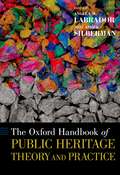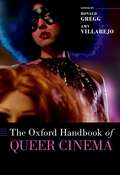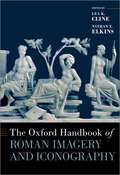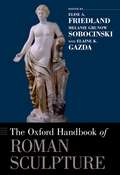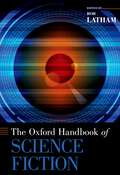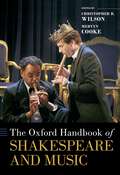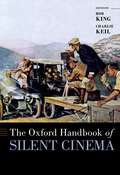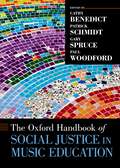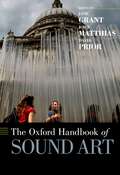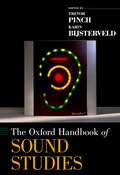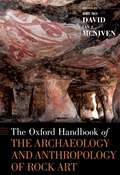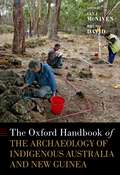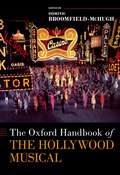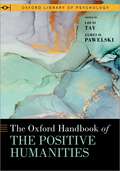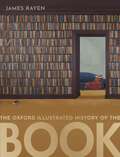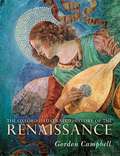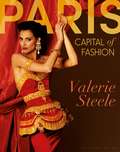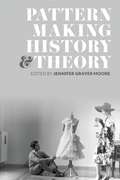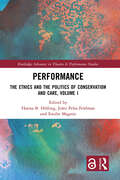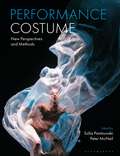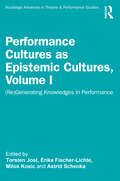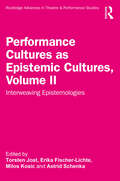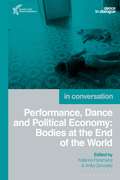- Table View
- List View
The Oxford Handbook of Public Heritage Theory and Practice (Oxford Handbooks)
The field of cultural heritage is no longer solely dependent on the expertise of art and architectural historians, archaeologists, conservators, curators, and site and museum administrators. It has dramatically expanded across disciplinary boundaries and social contexts, with even the basic definition of what constitutes cultural heritage being widened far beyond the traditional categories of architecture, artifacts, archives, and art. Heritage now includes vernacular architecture, intangible cultural practices, knowledge, and language, performances and rituals, as well as cultural landscapes. Heritage has also become increasingly entangled with the broader social, political, and economic contexts in which heritage is created, managed, transmitted, protected, or even destroyed. Heritage protection now encompasses a growing set of methodological approaches whose objectives are not necessarily focused upon the maintenance of material fabric, which has traditionally been cultural heritage's primary concern. The Oxford Handbook of Public Heritage Theory and Practice charts some of the major sites of convergence between the humanities and the social sciences, where new disciplinary perspectives are being brought to bear on heritage. These convergences have the potential to provide the interdisciplinary expertise needed not only to critique but also to achieve the intertwined intellectual, political, and socioeconomic goals of cultural heritage in the twenty-first century. This volume highlights the potential contributions of development studies, political science, anthropology, management studies, human geography, ecology, psychology, sociology, cognitive studies, and education to heritage studies.
The Oxford Handbook of Queer Cinema (Oxford Handbooks)
The term "queer cinema" is often used to name at least three cultural events: 1) an emergent visual culture that boldly identifies as queer; 2) a body of narrative, documentary, and experimental work previously collated under the rubric of homosexual or lesbian, gay, bisexual, and trans (LGBT) cinema; 3) a means of critically reading and evaluating films and other visual media through the lens of sexuality. By this expansive account, queer cinema encompasses more than a century of filmmaking, film criticism, and film reception, and the past twenty-five years have seen the idea of "queer cinema" expand further as a descriptor for a global arts practice. As the first of its kind, The Oxford Handbook of Queer Cinema treats these three currents as art and critical practice, bringing the canon of queer cinema together with a new generation of makers and scholars. The Handbook's contributors include scholars who research the worldwide canon of queer cinema, those who are uniquely positioned to address three decades of its particular importance, and those best positioned to ponder the forms it is taking or may take in our new century, namely digital media that moves in new circuits. In eight sections, they explore the many forms that queer cinema takes across time, discussing narrative, experimental, documentary, and genre filmmaking, including pornography. Likewise, although the study of cinema and media is not restricted to a single method, chapters showcase the unique combination of textual analysis, industrial and production history, interpretation, ethnography, and archival research that this field enables. For example, chapters analyze the ways in which queer cinema both is and is not self-evidently an object for study by examining films that reinforce negative understandings of queerness alongside those that liberate the subject; and by naming the films that are newly queered, while noting that many queerly-made texts await discovery. Finally, chapters necessarily assert that queer cinema is not an Anglophone phenomenon, nor is it restricted to the medium of film.
The Oxford Handbook of Roman Imagery and Iconography (Oxford Handbooks)
Imagery and iconography served specific functions in public, private, and ritual spheres in the Roman world. State-sanctioned imagery communicated politically charged ideas through an often-complex pictorial language, composed of emblems and attributes that signaled aspects of policy. In the private sphere, imagery communicated ethnic, social, and religious identities through specific signs, symbols, and forms, and through the emulation of state-sanctioned art. This volume focuses primarily on visual imagery in the Roman world, examined by context and period, and the evolving scholarly traditions of iconographic analysis and visual semiotics that have framed the modern study of these images. Among other subjects, essays touch on iconography and style in republican and early imperial art, public sculpture and social practice in the Roman Empire, coin iconography, funerary imagery, imagery in ritual use, and images and interpretation of Africans in Roman art. The Oxford Handbook of Roman Imagery and Iconography is an important reference work for both the communicative value of images in the Roman world and the tradition of iconographical analysis.
The Oxford Handbook of Roman Sculpture (Oxford Handbooks)
The study of Roman sculpture has been an essential part of the disciplines of Art History and Classics since the eighteenth century. Famous works like the Laoco?n, the Arch of Titus, and the colossal portrait of Constantine are familiar to millions. Again and again, scholars have returned to sculpture to answer questions about Roman art, society, and history. Indeed, the field of Roman sculptural studies encompasses not only the full chronological range of the Roman world but also its expansive geography, and a variety of artistic media, formats, sizes, and functions. Exciting new theories, methods, and approaches have transformed the specialized literature on the subject in recent decades. Rather than creating another chronological catalogue of representative examples from various periods, genres, and settings, The Oxford Handbook of Roman Sculpture synthesizes current best practices for studying this central medium of Roman art, situating it within the larger fields of Art History, Classical Archaeology, and Roman Studies. This comprehensive volume fills the gap between introductory textbooks and highly focused professional literature. The Oxford Handbook of Roman Sculpture conveniently presents new technical, scientific, literary, and theoretical approaches to the study of Roman sculpture in one reference volume while simultaneously complementing textbooks and other publications that present well-known works in the corpus. The contributors to this volume address metropolitan and provincial material from the early republican period through late antiquity in an engaging and fresh style. Authoritative, innovative, and up-to-date, The Oxford Handbook of Roman Sculpture will remain an invaluable resource for years to come.
The Oxford Handbook of Science Fiction (Oxford Handbooks)
The excitement of possible futures found in science fiction has long fired the human imagination, but the genre's acceptance by academe is relatively recent. No longer marginalized and fighting for respectability, science-fictional works are now studied alongside more traditional art forms. Tracing the capacious genre's birth, evolution, and impact across nations, time periods, subgenres, and media, The Oxford Handbook of Science Fiction offers an in-depth, comprehensive assessment of this robust area of scholarly inquiry and considers the future directions that will dictate the terms of the scholarly discourse. The Handbook begins with a focus on questions of genre, covering topics such as critical history, keywords, narrative, the fantastic, and fandom. A subsequent section on media engages with film, television, comics, architecture, music, video games, and more. The genre's role in the convergence of art and everyday life animates a third section, which addresses topics such as UFOs,
The Oxford Handbook of Shakespeare and Music (Oxford Handbooks)
The Oxford Handbook of Shakespeare and Music showcases the latest international research into the captivating and vast subject of the many uses of music in relation to Shakespeare's plays and poems, extending from the Bard's own time to the present day. The coverage is truly global in its scope, with ground-breaking studies of Shakespeare-related music in countries as diverse as China, the Czech Republic, France, Germany, India, Italy, Japan, Russia, South Africa, Sweden, and the Soviet Union, as well as the Anglophone musical and theatrical traditions of the UK and USA. The range of genres surveyed is equally extensive, embracing music for theatre, opera, ballet, musicals, the concert hall, and film, in addition to Shakespeare's ongoing afterlives in folk music, jazz, and popular music. The authors take a range of diverse approaches in tackling their remits: some chapters investigate the evidence for performative practices in the Early Modern and later eras, while others offer detailed accounts of representative case studies, situating these firmly in their cultural contexts, or reflecting on the fascinating political and sociological ramifications of the music. As a whole, the Handbook provides a unique and impressively wide-ranging compendium of cutting-edge scholarship engaging with an extraordinarily rich body of music.
The Oxford Handbook of Silent Cinema (Oxford Handbooks)
With thirty-four original chapters from three dozen top scholars, The Oxford Handbook of Silent Cinema provides a thoughtful and provocative re-examination of a medium that would become the dominant form of mass entertainment by the second decade of the twentieth century. The volume is arranged around a series of broad topics: the "invention" of cinema as both technology and medium; the intermedial development of film aesthetics and genres; nontheatrical and non-commercial uses of cinema; the political economy of Hollywood mass culture; film and global modernities; and silent cinema's publics and counter-publics. The historiographical essays in this collection engage with the question of how we might rethink silent film history, especially in the context of the developed media ecosystem that defined the early 1900s. Influenced by methodologies as diverse as media archaeology and industrial studies, and sensitive to both the textual contours of silent films and the cultural, economic, and ideological currents that helped shape them, the Oxford Handbook of Silent Cinema invites its reader to envision its object in expansive terms that incorporate the propulsive energy of the first decades of the 1900s and deploy the analytical frameworks of the current day.
The Oxford Handbook of Social Justice in Music Education (Oxford Handbooks)
Music education has historically had a tense relationship with social justice. One the one hand, educators concerned with music practices have long preoccupied themselves with ideas of open participation and the potentially transformative capacity that musical interaction fosters. On the other hand, they have often done so while promoting and privileging a particular set of musical practices, traditions, and forms of musical knowledge, which has in turn alienated and even excluded many children from music education opportunities. The Oxford Handbook of Social Justice in Music Education provides a comprehensive overview and scholarly analyses of the major themes and issues relating to social justice in musical and educational practice worldwide. The first section of the handbook conceptualizes social justice while framing its pursuit within broader contexts and concerns. Authors in the succeeding sections of the handbook fill out what social justice entails for music teaching and learning in the home, school, university, and wider community as they grapple with cycles of injustice that might be perpetuated by music pedagogy. The concluding section of the handbook offers specific practical examples of social justice in action through a variety of educational and social projects and pedagogical practices that will inspire and guide those wishing to confront and attempt to ameliorate musical or other inequity and injustice. Consisting of 42 chapters by authors from across the globe, the handbook will be of interest to anyone who wishes to better understand what social justice is and why its pursuit in and through music education matters.
The Oxford Handbook of Sound Art (Oxford Handbooks)
Sound art has long been resistant to its own definition. Emerging from a liminal space between movements of thought and practice in the twentieth century, sound art has often been described in terms of the things that it is understood to have left behind: a space between music, fine art, and performance. The Oxford Handbook of Sound Art surveys the practices, politics, and emerging frameworks of thought that now define this previously amorphous area of study. Throughout the Handbook, artists and thinkers explore the uses of sound in contemporary arts practice. Imbued with global perspectives, chapters are organized in six overarching themes of Space, Time, Things, Fabric, Senses and Relationality. Each theme represents a key area of development in the visual arts and music during the second half of the twentieth century from which sound art emerged. By offering a set of thematic frameworks through which to understand these themes, this Handbook situates constellations of disparate thought and practice into recognized centers of activity.
The Oxford Handbook of Sound Studies (Oxford Handbooks)
Written by the world's leading scholars and researchers in the emerging field of sound studies, The Oxford Handbook of Sound Studies offers new and fully engaging perspectives on the significance of sound in its material and cultural forms. The book considers sounds and music as experienced in such diverse settings as shop floors, laboratories, clinics, design studios, homes, and clubs, across an impressively broad range of historical periods and national and cultural contexts. Science has traditionally been understood as a visual matter, a study which has historically been undertaken with optical technologies such as slides, graphs, and telescopes. This book questions that notion powerfully by showing how listening has contributed to scientific practice. Sounds have always been a part of human experience, shaping and transforming the world in which we live in ways that often go unnoticed. Sounds and music, the authors argue, are embedded in the fabric of everyday life, art, commerce, and politics in ways which impact our perception of the world. Through an extraordinarily diverse set of case studies, authors illustrate how sounds -- from the sounds of industrialization, to the sounds of automobiles, to sounds in underwater music and hip-hop, to the sounds of nanotechnology -- give rise to new forms listening practices. In addition, the book discusses the rise of new public problems such as noise pollution, hearing loss, and the "end" of the amateur musician that stem from the spread and appropriation of new sound- and music-related technologies, analog and digital, in many domains of life. Rich in vivid and detailed examples and compelling case studies, and featuring a companion website of listening samples, this remarkable volume boldly challenges readers to rethink the way they hear and understand the world.
The Oxford Handbook of the Archaeology and Anthropology of Rock Art (Oxford Handbooks)
Rock art is one of the most visible and geographically widespread of cultural expressions, and it spans much of the period of our species' existence. Rock art also provides rare and often unique insights into the minds and visually creative capacities of our ancestors and how selected rock outcrops with distinctive images were used to construct symbolic landscapes and shape worldviews. Equally important, rock art is often central to the expression of and engagement with spiritual entities and forces, and in all these dimensions it signals the diversity of cultural practices, across place and through time. Over the past 150 years, archaeologists have studied ancient arts on rock surfaces, both out in the open and within caves and rock shelters, and social anthropologists have revealed how people today use art in their daily lives. The Oxford Handbook of the Archaeology and Anthropology of Rock Art showcases examples of such research from around the world and across a broad range of cultural contexts, giving a sense of the art's regional variability, its antiquity, and how it is meaningful to people in the recent past and today - including how we have ourselves tended to make sense of the art of others, replete with our own preconceptions. It reviews past, present, and emerging theoretical approaches to rock art investigation and presents new, cutting-edge methods of rock art analysis for the student and professional researcher alike.
The Oxford Handbook of the Archaeology of Indigenous Australia and New Guinea (Oxford Handbooks)
65,000 years ago, modern humans arrived in Australia, having navigated more than 100 km of sea crossing from southeast Asia. Since then, the large continental islands of Australia and New Guinea, together with smaller islands in between, have been connected by land bridges and severed again as sea levels fell and rose. Along with these fluctuations came changes in the terrestrial and marine environments of both land masses. The Oxford Handbook of the Archaeology of Indigenous Australia and New Guinea reviews and assembles the latest findings and ideas on the archaeology of the Australia-New Guinea region, the world's largest island-continent. In 42 new chapters written by 77 contributors, it presents and explores the archaeological evidence to weave stories of colonisation; megafaunal extinctions; Indigenous architecture; long-distance interactions, sometimes across the seas; eel-based aquaculture and the development of techniques for the mass-trapping of fish; occupation of the High Country, deserts, tropical swamplands and other, diverse land and waterscapes; and rock art and symbolic behaviour. Together with established researchers, a new generation of archaeologists present in this Handbook one, authoritative text where Australia-New Guinea archaeology now lies and where it is heading, promising to shape future directions for years to come.
The Oxford Handbook of the Hollywood Musical (OXFORD HANDBOOKS SERIES)
Since the release of Baz Luhrmann's Moulin Rouge! in 2001, the film musical has returned to popularity as one of the most important cinematic genres, with box office hits that appeal to audiences of all ages. Yet the history of the musical on film goes back over seven decades earlier, stretching from early examples like The Jazz Singer (1927), the first ever film with synchronized sound, through the Astaire-Rogers musicals of the 1930s, the MGM and Warner Brothers extravaganzas of the 1940s and '50s, and the roadshow era of the 1960s. The genre's renaissance with La La Land (2016) and The Greatest Showman (2017) proves that it remains as appealing as ever, capable of both high critical acclaim and widespread box office success. The Oxford Handbook of the Hollywood Musical, curated by editor Dominic Broomfield-McHugh, reflects and expands on current scholarship on the film musical in a handbook that mixes new discoveries through archival research with new perspectives on familiar titles. It addresses issues such as why audiences accept people bursting into song in musicals; how technology affects the way numbers are staged; and how writers have adapted their material to suit certain stars. It also looks at critical issues such as racism and sexism, and assesses the role and nature of the film musical in the twenty-first century. A remarkable survey at the cutting edge of the field, The Oxford Handbook of the Hollywood Musical will be a resource for students and scholars alike for years to come.
The Oxford Handbook of the Positive Humanities (Oxford Library of Psychology)
This handbook examines the new and rapidly growing field of the positive humanities--an area of academic research at the intersection of positive psychology and the arts and humanities. Written by leading experts across a wide range of academic disciplines, the volume begins with an overview of the science and culture of human flourishing, covering historical and current trends in this literature. Next, contributors consider the well-being benefits of engagement with the arts and humanities, marking out neurological, cognitive, emotional, behavioral, and social pathways to human flourishing. These pathways lead to detailed investigations of individual fields within the arts and humanities, including music, the visual arts, philosophy, history, literature, religion, theater, and film. Along the way, the book thoroughly synthesizes theory, research, and exemplary practice, concluding with thought-provoking discussions of avenues for public engagement and policy. With its expansive coverage of both the field as a whole and specialized disciplinary and interdisciplinary drivers, The Oxford Handbook of the Positive Humanities advances the literature on the theory and science of well-being and extends the scope of the arts and humanities.
The Oxford Illustrated History of the Book (Oxford Illustrated History)
In 14 original essays, The Oxford Illustrated History of the Book reveals the history of books in all their various forms, from the ancient world to the digital present. Leading international scholars offer an original and richly illustrated narrative that is global in scope. The history of the book is the history of millions of written, printed, and illustrated texts, their manufacture, distribution, and reception. Here are different types of production, from clay tablets to scrolls, from inscribed codices to printed books, pamphlets, magazines, and newspapers, from written parchment to digital texts. The history of the book is a history of different methods of circulation and dissemination, all dependent on innovations in transport, from coastal and transoceanic shipping to roads, trains, planes and the internet. It is a history of different modes of reading and reception, from learned debate and individual study to public instruction and entertainment. It is a history of manufacture, craftsmanship, dissemination, reading and debate. Yet the history of books is not simply a question of material form, nor indeed of the history of reading and reception. The larger question is of the effect of textual production, distribution and reception - of how books themselves made history. To this end, each chapter of this volume, succinctly bounded by period and geography, offers incisive and stimulating insights into the relationship between books and the story of their times.
The Oxford Illustrated History of the Renaissance (Oxford Illustrated History)
The Renaissance is one of the most celebrated periods in European history. But when did it begin? When did it end? And what did it include? Traditionally regarded as a revival of classical art and learning, centred upon fifteenth-century Italy, views of the Renaissance have changed considerably in recent decades. The glories of Florence and the art of Raphael and Michelangelo remain an important element of the Renaissance story, but they are now only a part of a much wider story which looks beyond an exclusive focus on high culture, beyond the Italian peninsula, and beyond the fifteenth century. The Oxford Illustrated History of the Renaissance tells the cultural history of this broader and longer Renaissance: from seminal figures such as Dante and Giotto in thirteenth-century Italy, to the waning of Spain's 'golden age' in the 1630s, and the closure of the English theatres in 1642, the date generally taken to mark the end of the English literary Renaissance. Geographically, the story ranges from Spanish America to Renaissance Europe's encounter with the Ottomans—and far beyond, to the more distant cultures of China and Japan. And thematically, under Gordon Campbell's expert editorial guidance, the volume covers the whole gamut of Renaissance civilization, with chapters on humanism and the classical tradition; war and the state; religion; art and architecture; the performing arts; literature; craft and technology; science and medicine; and travel and cultural exchange.
Paris, Capital of Fashion
Paris, Capital of Fashion accompanies a major exhibition at The Museum at FIT, New York's only museum dedicated solely to the art of fashion. This lavishly-illustrated book is edited by MFIT's director and chief curator, Valerie Steele, also the author of the acclaimed Paris Fashion: A Cultural History. This new book opens with an important essay on how and why Paris became famous as the international “capital of fashion.”Steele traces how the mythic “aura” of Paris fashion was constructed over generations, as the splendour of the court at Versailles came to be echoed by the spectacle of the haute couture. Yet Paris has faced repeated challenges from other fashion capitals, especially London, Milan, and New York. Essays by Christopher Breward, David Gilbert, Grazia d'Annunzio, and Antonia Finnane place Paris within a broader global narrative, while Sophie Kurkdjian investigates the cultural value of the Parisian couture, and Agnès Rocomora explores the online imagery of the chic Parisienne.As The New Yorker recently put it, Paris is “the most glamorous and competitive of the world's fashion capitals.” No other city has been branded “Fashion” as Paris has. By opening the study of Paris fashion to new approaches, this book explains why Paris still retains its position as the world's undisputed fashion capital.
Parthenon, Greece (UEB Contracted)
This is an image of the end view of the Parthenon at the Acropolis. There is a locator dot shown, which will be at the top left of the page when the image is the right way up. It is an ancient Greek temple built between 447- 432 B.C. It now lies in ruin, so the stonework is rugged and irregular where it has worn away or is missing. A dashed line image border surrounds it. There are low steps with large chunks of stone missing along the base of the page, which run the width of the page. Up from these are eight Doric columns, which all have rough jagged sides. The columns rise up the page to support a series of ornamental blocks triglyphs and metopes. Above these is the pediment where a sculpted frieze would once have been.
Parthenon, Greece (UEB uncontracted)
This is an image of the end view of the Parthenon at the Acropolis. There is a locator dot shown, which will be at the top left of the page when the image is the right way up. It is an ancient Greek temple built between 447- 432 B.C. It now lies in ruin, so the stonework is rugged and irregular where it has worn away or is missing. A dashed line image border surrounds it. There are low steps with large chunks of stone missing along the base of the page, which run the width of the page. Up from these are eight Doric columns, which all have rough jagged sides. The columns rise up the page to support a series of ornamental blocks triglyphs and metopes. Above these is the pediment where a sculpted frieze would once have been.
Patternmaking History and Theory
Fashion design is increasingly gaining attention as an important form of cultural expression. However, scholarship has largely focused on specific designers and their finished products. This collection reveals the crucial foundational art and craft of patternmaking design, with essays that explore the practice in specific historical and cultural contexts. Probing the theoretical underpinnings that inform patternmaking, Patternmaking History and Theory interrogates topics that span cultures and time periods, ranging from high fashion to home sewing. Taking the reader from women's making and mending for victory during World War Two, to Jamaican dress history and today's complex 3D pattern cutting software, the book examines the creative aspect of a culturally rich skill. Beautifully illustrated and rooted in original research, Patternmaking History and Theory brings together a group of leading international scholars to provide a range of perspectives on a key but often overlooked aspect of design.
Performance: The Ethics and the Politics of Conservation and Care, Volume I (Routledge Advances in Theatre & Performance Studies)
This book focuses on performance and performance-based artworks as seenthrough the lens of conservation, which has long been overlooked in the largertheoretical debates about whether and how performance remains. Unraveling the complexities involved in the conservation of performance,Performance: The Ethics and the Politics of Conservation and Care (vol. 1)brings this new understanding to bear in examining performance as an object ofstudy, experience, acquisition, and care. In so doing, it presents both theoreticalframeworks and functional paradigms for thinking about—and enacting—theconservation of performance. Further, while the conservation of performance isundertheorized, performance is nevertheless increasingly entering the artmarket and the museum, meaning that there is an urgent need for discourse onhow to care for these works long-term. In recent years, a few pioneering conservators,curators, and scholars have begun to create frameworks for the longtermcare of performance. This volume presents, explicates, and contextualizestheir work so that a larger discourse can commence. It will thus serve the needsof conservation students and professors, for whom literature on this subject issorely needed. This interdisciplinary book thus implements a novel rethinking of performancethat will challenge and revitalize its conception in many fields, such as art history,theater, performance studies, heritage studies, and anthropology.
Performance Costume: New Perspectives and Methods
Costume is an active agent for performance-making; it is a material object that embodies ideas shaped through collaborative creative work. A new focus in recent years on research in the area of costume has connected this practice in vital and new ways with theories of the body and embodiment, design practices, artistic and other forms of collaboration. Costume, like fashion and dress, is now viewed as an area of dynamic social significance and not simply as passive reflector of a pre-conceived social state or practice. This book offers new approaches to the study of costume, as well as fresh insights into the better-understood frames of historical, theoretical, practice-based and archival research into costume for performance.This anthology draws on the experience of a global group of established researchers as well as emerging voices. Below is a list of just some of the things it achieves:1. Introduces diverse perspectives, innovative new research methods and approaches for researching design and the costumed body in performance.2. Contributes towards a new understanding of how costume actually 'performs' in time and space.3. Offers new insights into existing practices, as well as creating a space of connection between practitioners and researchers from design, the humanities and social sciences.
Performance Cultures as Epistemic Cultures, Volume I: (Re)Generating Knowledges in Performance (Routledge Advances in Theatre & Performance Studies)
This volume investigates performances as situated "machineries of knowing" (Karin Knorr Cetina), exploring them as relational processes for, in and with which performers as well as spectators actively (re)generate diverse practices of knowing, knowledges and epistemologies. Performance cultures are distinct but interconnected environments of knowledge practice. Their characteristic features depend not least on historical as well as contemporary practices and processes of interweaving performance cultures. The book presents case studies from diverse locations around the globe, including Argentina, Canada, China, Greece, India, Poland, Singapore, and the United States. Authored by leading scholars in theater, performance and dance studies, its chapters probe not only what kinds of knowledges are (re)generated in performances, for example cultural, social, aesthetic and/or spiritual knowledges; the contributions investigate also how performers and spectators practice knowing (and not-knowing) in performances, paying particular attention to practices and processes of interweaving performance cultures and the ways in which they contribute to shaping performances as dynamic "machineries of knowing" today. Ideal for researchers, students and practitioners of theater, performance and dance, (Re)Generating Knowledges in Performance explores vital knowledge-serving functions of performance, investigating and emphasizing in particular the impact and potential of practices and processes of interweaving of performance cultures that enable performers and spectators to (re)generate crucial knowledges in increasingly diverse ways.
Performance Cultures as Epistemic Cultures, Volume II: Interweaving Epistemologies (Routledge Advances in Theatre & Performance Studies)
This volume investigates performance cultures as rich and dynamic environments of knowledge practice through which distinctive epistemologies are continuously (re)generated, cultivated and celebrated. Epistemologies are dynamic formations of rules, tools and procedures not only for understanding but also for doing knowledges. This volume deals in particular with epistemological challenges posed by practices and processes of interweaving performance cultures. These challenges arise in artistic and academic contexts because of hierarchies between epistemologies. European colonialism worked determinedly, violently and often with devastating effects on instituting and sustaining a hegemony of modern Euro-American rules of knowing in many parts of the world. Therefore, Interweaving Epistemologies critically interrogates the (im)possibilities of interweaving epistemologies in artistic and academic contexts today. Writing from diverse geographical locations and knowledge cultures, the book’s contributors—philosophers and political scientists as well as practitioners and scholars of theater, performance and dance—investigate prevailing forms of epistemic ignorance and violence. They introduce key concepts and theories that enable critique of unequal power relations between epistemologies. Moreover, contributions explore historical cases of interweaving epistemologies and examine innovative present-day methods of working across and through epistemological divides in nonhegemonic, sustainable, creative and critical ways. Ideal for practitioners, students and researchers of theater, performance and dance, Interweaving Epistemologies emphasizes the urgent need to acknowledge, study and promote epistemological plurality and diversity in practices of performance-making as well as in scholarship on theater and performance around the globe today.
Performance, Dance and Political Economy: Bodies at the End of the World (Dance in Dialogue)
This book examines the relation between bodies and political economies at micro and macro levels. It stands in the space between ends and beginnings – some long-desired, such as the end of capitalism and racism, and others long-dreaded, such as the climate catastrophe – and reimagines what the world can be like instead. It offers an original investigation into the relation between performance, dance, and political economy, looking at the points where politics, economics, ethics, and culture intersect. Arising from live conversations and exchanges among the contributors, this book is written in an interdisciplinary and dialogical manner by leading scholars and artists in the fields of Performance Studies, Dance, Political Theory, Economics, and Social Theory: Marc Arthur, Melissa Blanco Borelli, Anita Gonzalez, Alexandrina Hemsley, Jamila Johnson-Small, Elena Loizidou, Tavia Nyong'o, Katerina Paramana, Nina Power, and Usva Seregina. Their critical and creative examinations of the relation between bodies and political economy offer insights for both imagining and materializing a world beyond the present.
